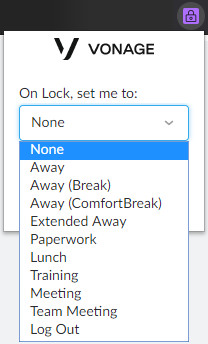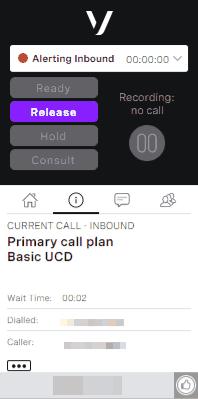In this page | |
|---|---|
|
General Availability Features
Vonage integration
Vonage rebrand
Your NVM Contact Center has got a new name and a new look—but, other than new Spring '20 features, its functionality has stayed the same. The NVM brand has been sunsetted, so all our products and communications now bear the Vonage brand. It’s most obvious at log in, across your Admin Portal, and on ContactPad. The product name has changed to Vonage Contact Center—because the Vonage brand is all about being clear and straightforward in everything we do.
We have not updated some occurrences of ‘NewVoiceMedia’, ‘NVM’, ‘ContactWorld’, and so on, in our products and consequently in the documentation. Most of these occurrences are internal names used within our integration packages or in code. Changing these names could break existing integrations.
Vonage Contact Center and Vonage Business Communications integration
This Spring we are integrating Vonage Contact Center (VCC)—formerly NewVoiceMedia—and Vonage Business Communications (VBC)—formerly Vonage Business Cloud. This integration will provide the following benefits:
...
More information will follow shortly.
Sales
Salesforce High Velocity Sales (HVS) Integration
Spring '20 included HVS Integration which integrates Vonage Contact Center with Salesforce's High Velocity Sales (HVS) product. If enabled for your account, your agents can contact leads using ContactPad. Those leads can progress through the cadence process based on the outcome of calls made.
For information about HVS integration, see High Velocity Sales (HVS) Engagement Powered by Vonage.
User experience
Screen Lock for Vonage Contact Center
The Screen Lock for Vonage Contact Center extension updates an agent's state whenever their computer locks—either manually, by the agent, or automatically, due to inactivity.
The agent can choose from Away, Extended Away or Log Out states, plus any minor states within them. Changing their state to one of these will prevent Vonage Contact Center from delivering interactions that the agent is unable to handle because their computer is locked.
For more information, see ContactPad with Screen Lock for Vonage Contact Center.
Telecommunications
CLI validation changes (UK)
New regulations in the UK require us to validate caller line identities (CLIDs). The CLIDs must be both in a valid format and within a valid range. Vonage Contact Center is being updated to validate CLIDs that we receive and replace them, where required, to ensure the call continues correctly.
Vonage Contact Center WebRTC
From Spring '20, existing WebRTC customers are being migrated to our own WebRTC implementation. Administrators need to update firewalls to allow traffic from a new list of IP addresses. When configured correctly, agents will not notice any changes before, during, or after migration.
For information about using Vonage Contact Center with WebRTC, see ContactPad with WebRTC.
Report audio problems
Using ContactPad, from Spring '20 onward, agents can report any audio problems experienced during a call. Reportable problems include echo, distortion, delay, and so on. Any problems with inbound calls are viewable in Dashboards.
For information about reporting audio problems, see Reporting audio problems in ContactPad.
Recording
Auto pause/resume recordings when going on/off hold
By default, when an agent puts a call—which is being recorded—on hold, Vonage Contact Center continues to record the call. Agents must manually pause and resume call recording before and after putting the call on hold if they wish to stop recording.
...
For information about automatically pausing and resuming recordings, see Call recording.
Interaction Architect
Set Data Source enhancement
Previously, administrators could create one data source in each Set Data Source applet. Since Spring '20, administrators can create, or delete, up to 100 data sources using the Set Data Source applet.
For information about the Set Data Source applet, see Set Data Source applet.
User Admin
Scheduled logout (previously limited availability—generally available from Spring '20)
If an agent forgets to log out of ContactPad at the end of their shift, Vonage Contact Center may deliver an interaction to them that they are unavailable to work with.
...
For information about configuring schedules that define when to log agents out of ContactPad, see Configuring logout schedules.
Custom unexpected and fault state timeouts (previously limited availability—generally available from Spring '20)
Previously administrators could configure the timeout period of unexpected and fault states at group level only. Since Spring '20, administrators can configure custom timeouts at agent level for the following states:
...
For information about configuring custom unexpected and fault state timeouts, see Configuring individual users.
Reporting
Advanced Reporting and Statistics in Salesforce
Since Spring '20, the Advanced Reporting and Statistics package is generally available in Salesforce if enabled for your account.
For information about Advanced Reporting and Statistics, see Advanced Reporting and Statistics in Salesforce.
Dashboards
External data integration for Dashboards (previously known as Insights Data Source Mapping)
If data source data is available for interactions, since Spring '20, administrators can configure their Vonage Contact Center account to make that information available as custom metrics in Dashboards. When configured, this information is also accessible through the Insights Stats API.
For information about viewing data source data in Dashboards, see Viewing mapped data source data in DashboardsReal-time Analytics.
Conversation Analyzer
Adding new languages to Conversation Analyzer
Previously, Conversation Analyzer supported six languages. In the Spring release, this support was extended to handle twenty two languages.
...
Furthermore, English (Global) transcription has been improved.
Pilot
Global PCI
IVR secure payments
IVR secure payments, available as a pilot feature in Spring '20, extends PCI Pal Agent Assist Secure Payments to enable agents to take secure payments through an IVR.
Firstly, a Data Connector obtains cardholder data. The secure PCI Pal IVR service then collects sensitive credit card information and transmits that data to your merchant payment service provider for processing. The Data Connector can write transaction results into a backend system.
Virtual Assistant (pilot)
Our Virtual Assistant uses artificial intelligence to:
...

